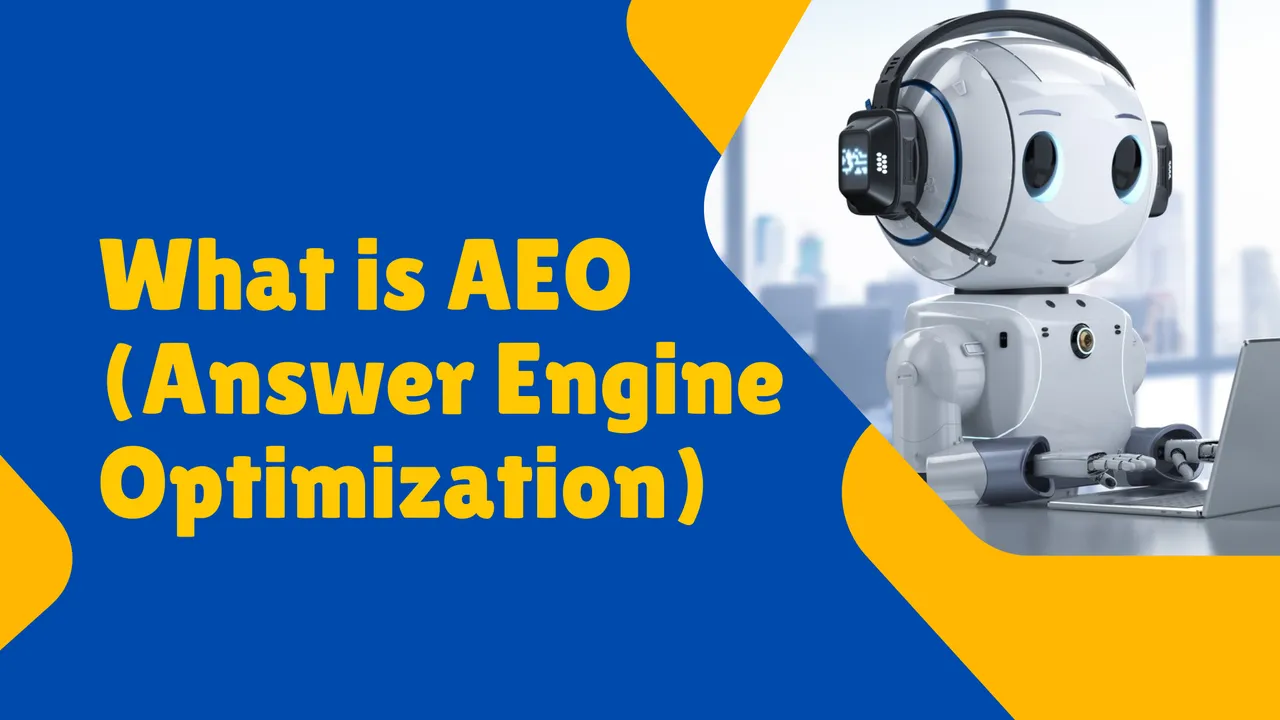
Did you know that nearly two-thirds of Google searches now end without a click to any website? That’s a staggering statistic that should make every marketer and business owner pause. For years, the goal was to rank first on the search engine results page (SERP). But what happens when the SERP itself provides the answer, making a click unnecessary? This is the new reality shaped by the rise of voice assistants like Google Assistant and Amazon Alexa, which now inhabit millions of homes and pockets worldwide.
The game has fundamentally changed. Traditional Search Engine Optimization (SEO), with its primary focus on ranking a list of blue links, is no longer the complete playbook. We’ve shifted from a world of search engines to a world of answer engines. Relying solely on old-school tactics is like bringing a map to a world navigated by GPS; you might get there eventually, but you’re missing the most direct and efficient route.
This is where Answer Engine Optimization (AEO) comes in. AEO is the necessary evolution of our digital strategies, a pivot from simply being on the results page to being the result. This comprehensive guide is designed to walk you through everything you need to know about AEO. We’ll explore its core concepts, demystify the technology behind it, and provide actionable AEO strategies you can implement today to secure your visibility in 2025 and well into the future.
What Is Answer Engine Optimization (AEO)? From Search to Answers
At its heart, Answer Engine Optimization (AEO) is the process of optimizing your digital content to directly answer questions and be featured in rich, on-SERP formats. It’s a strategic pivot from the traditional SEO goal of driving traffic to a webpage towards the new imperative of becoming the definitive answer itself. Think about how you use Google today. When you ask, “what’s the weather like?” you don’t want a list of weather websites; you want the temperature. When you ask your phone to “set a timer for 10 minutes,” you expect an action, not a link. This fundamental shift in user behavior has transformed search engines. They are no longer just catalogs of the web; they are “question-answering” machines.
An Answer Engine—a term that now aptly describes Google, Bing, and even DuckDuckGo—aims to understand a user’s intent and provide the most accurate and concise answer directly on the results page. This minimizes the effort for the user, creating a seamless and efficient experience. AEO is the practice of aligning your content and technical strategy with this goal. It involves understanding the questions your audience is asking, structuring your content to provide clear and direct answers, and using technical signals like structured data to help search engines understand and feature your information. It’s about making your content the most convenient and trustworthy source, so the answer engine chooses you.
The End of the 10 Blue Links: Why AEO Matters Now
The classic “10 blue links” on a Google results page are becoming a relic of a bygone era. For a significant portion of queries, especially informational and simple transactional ones, the user’s journey ends on the SERP itself. This is the world of the “zero-click search,” a phenomenon that has been steadily growing. These are searches where the user’s query is answered directly on the results page via a Featured Snippet, a Knowledge Panel, a “People Also Ask” box, or another rich result. They find what they need without ever clicking through to a website. While this might sound alarming, it presents a monumental opportunity for brands that adapt.
Why does this matter so profoundly now? The primary driver is the proliferation of new search interfaces. The rise of voice search through devices like Google Assistant, Amazon Alexa, and Apple Siri has completely changed the input method. Users are speaking their queries conversationally, and they expect a single, spoken answer in return. There are no “10 blue links” in a voice search result. There is only one answer. Furthermore, the visual interface of search on mobile and desktop is evolving. Google is increasingly using its vast understanding of the world—its Knowledge Graph—to present information in more dynamic, answer-oriented formats. Ignoring AEO means you are forfeiting visibility on these rapidly growing and highly engaging platforms. It’s no longer about just being in the top 10; it’s about being the one.
AEO vs. SEO: Understanding the Critical Differences and Synergies
It’s tempting to see AEO as a complete replacement for SEO, but that’s not quite right. Think of AEO as a specialized discipline within the broader field of SEO. It’s an evolution, not a revolution.
- SEO (Search Engine Optimization) is the foundational work: technical site health, backlink building, mobile-friendliness, and broad keyword targeting. It’s about making your website easily crawlable and authoritative in the eyes of the search engine.
- AEO (Answer Engine Optimization) builds on that foundation with a laser focus on intent and delivery. It’s about structuring your content to be the definitive answer to specific questions. It’s less about ranking for “digital cameras” and more about becoming the featured answer for “what is the best mirrorless camera for travel.”
They work in synergy. You cannot have a successful AEO strategy without a solid SEO foundation. Your site must be technically sound and trustworthy for Google to even consider using your content as a direct answer.
Key Players in the Answer Ecosystem: From Google Assistant to Apple Siri
The drive towards answers isn’t confined to a desktop search bar. It’s a vast ecosystem of devices and platforms all powered by the same underlying principle. The major players include:
- Google Assistant: The most ubiquitous voice assistant, deeply integrated into Android phones, smart speakers, and displays.
- Amazon Alexa: The dominant force in the smart home market, answering questions and performing tasks on Echo devices.
- Apple Siri: The original voice assistant, integrated across iPhones, iPads, and HomePods.
- Microsoft Cortana: Integrated into Windows and other Microsoft products.
When you optimize for answers, you’re not just optimizing for a Google search. You’re optimizing for a voice query on a Google Nest Hub, a question posed to Siri on an Apple Watch, or a search on Bing. This multi-platform presence is what makes AEO so powerful.
The Core Pillars: How Answer Engines Actually Work
To truly master Answer Engine Optimization, you can’t just follow a checklist; you need to understand the fundamental technology that makes it all possible. Peeking under the hood of an answer engine like Google reveals a sophisticated system designed not just to find keywords, but to understand concepts, relationships, and trust. This is what sets this article apart—we’re not just giving you the “what,” but the “why” and the “how.” By demystifying these core pillars, you’ll be better equipped to create content that naturally aligns with how these systems work, setting you up for long-term success. This isn’t about gaming an algorithm; it’s about speaking its language.
This section will take you on a deep dive into the foundational technologies that power modern search. We’ll explore the move from simple keyword matching to a complex web of interconnected entities. We’ll break down the artificial intelligence that allows Google to understand language with human-like nuance. And most importantly, we’ll connect it all back to the critical importance of being a trusted source. Let’s pull back the curtain on the magic of answer engines.
The Knowledge Graph: Building a Web of Entities, Not Strings
The biggest leap in modern search was the shift from “strings to things.” In the past, Google saw keywords as simple text strings. Now, it understands them as entities—real-world objects, people, places, concepts, and the relationships between them. This interconnected database of entities is known as the Knowledge Graph. When you search for “Leonardo da Vinci,” Google doesn’t just see those words; it accesses its entity for the historical figure, connecting him to the Mona Lisa (another entity), Florence (a location entity), and his birth date (a data entity). Pioneers in this space, like the late Bill Slawski who decoded Google’s patents, and experts like Jason Barnard, who focuses on Brand SERP optimization, have shown that the goal is to get your brand, your products, and your people established as distinct entities within Google’s Knowledge Graph and its Bing equivalent, Satori.
Semantic Search & NLP: How Google Understands Your Questions
How does Google decipher the often messy, conversational, and nuanced way we ask questions? Through Semantic Search and Natural Language Processing (NLP). These technologies allow the engine to understand context, not just keywords. Key components include:
- BERT (Bidirectional Encoder Representations from Transformers): A groundbreaking model that helps Google understand the relationship between words in a sentence. It can grasp nuance, prepositions, and context, making search results far more accurate for conversational queries.
- MUM (Multitask Unified Model): The next evolution, reportedly 1,000 times more powerful than BERT. MUM can understand information across different languages and formats (text, images, video) to answer complex questions that don’t have a direct answer in any single source.
- RankBrain: An AI system that helps Google process and understand ambiguous or novel search queries it has never seen before.
These systems work together to move beyond keywords and get to the heart of what the user truly wants to know.
The Trinity of Trust: Why E-A-T (Expertise, Authoritativeness, Trustworthiness) is Crucial for AEO
If you want to be the source of answers, the engine must trust you implicitly. This is where Google’s E-A-T framework becomes paramount for AEO. For any given topic, Google wants to provide an answer from a source that demonstrates:
- Expertise: Is the content created by a subject matter expert?
- Authoritativeness: Is the website and the author widely recognized as an authority on the topic?
- Trustworthiness: Is the information accurate, reliable, and secure?
E-A-T is especially critical for YMYL (Your Money Your Life) topics—finance, health, safety—where a wrong answer could have serious consequences. For AEO, demonstrating high E-A-T tells Google that your content is not just relevant but also a safe and reliable source to present as a definitive answer.
How to Do AEO: Your 5-Step AEO Optimization Framework
Now for the most important part: How do you actually do AEO? This isn’t about guesswork; it’s about following a structured process. This five-step framework is your blueprint for effective aeo optimization, designed to build authority and capture those coveted answer spots. It’s a process we at ITxITPro have refined to help clients transition their thinking from ranking links to owning answers.
Step 1: Identify and Answer Your Audience’s Core Questions
The foundation of any great AEO strategy is a deep understanding of the questions your audience is asking. Your goal is to become the ultimate resource for their curiosities, problems, and needs.
- Dive into “People Also Ask”: The PAA boxes on Google are a goldmine. For any of your primary topics, see what questions Google itself is highlighting.
- Use Keyword Research Tools for Questions: Tools like Ahrefs, SEMrush, and AnswerThePublic have specific features to find keywords phrased as questions (who, what, where, when, why, how).
- Monitor Conversational Queries: Think about how people would speak their search. “Best restaurants near me” becomes a keyword, but “What’s a good place to eat downtown that has outdoor seating?” is a conversational query you need to be prepared to answer.
Step 2: Create In-Depth, Well-Structured Content
Once you know the questions, you need to create content that provides the best, most comprehensive answers. The structure of this content is critical for answer engines to parse and understand it.
- The Inverted Pyramid: Answer the question directly and concisely right at the beginning of your content. This “answer-first” approach is perfect for being picked up for a Featured Snippet. Provide the deep-dive explanation and context afterward.
- Use Semantic HTML: Structure your content logically with proper heading tags (H1, H2, H3), bulleted lists (<ul>), and numbered lists (<ol>). This isn’t just for aesthetics; it provides a clear content hierarchy for search engine crawlers.
- Embrace the Q&A Format: Don’t be afraid to dedicate entire sections of your articles, or even entire articles, to a simple Question-and-Answer format. This explicitly signals to answer engines what query your content is addressing.
Step 3: Implement Structured Data with Schema.org
If content structure is the blueprint, Structured Data is the set of explicit instructions that leaves no room for interpretation. Using the Schema.org vocabulary, you can label your content in a way that search engines understand perfectly.
- Use JSON-LD: This is Google’s preferred format for implementing structured data. It’s a script you add to your page’s header or body that describes the content.
- Deploy Specific Schemas: Don’t just use one generic schema. Use the most relevant types for your content. The FAQPage schema is essential for Q&A content, HowTo schema is perfect for step-by-step guides, and Person or Organization schema helps define you as an entity. This technical markup is a cornerstone of advanced aeo strategies.
Step 4: Build Your Brand as a Recognised Entity
The ultimate goal of AEO is for Google to see your brand not just as a website, but as a verified entity—a definitive source of information on your topic. This goes beyond your own website.
- Get Your Knowledge Panel: A Knowledge Panel is the information box that appears on the right side of the SERP for a branded search. Claiming and controlling this is a powerful signal of authority.
- Leverage External Platforms: Build your entity’s footprint on trusted, third-party knowledge bases. Creating and curating a profile on Wikidata is a powerful step.
- Use Entity-Building Tools: Services like WordLift and InLinks specialize in building out your internal knowledge graph and explicitly defining entities and their relationships within your content, helping search engines connect the dots and solidify your authority.
Step 5: Master On-SERP SEO: Winning the Zero-Click Search
On-SERP SEO is the art and science of maximizing your visibility directly on the search results page itself. This is where your AEO efforts bear fruit.
- Target Featured Snippets: Use the “answer-first” content structure, provide clear definitions, and use question-based headings to capture these “position zero” spots.
- Dominate People Also Ask (PAA): By creating concise, well-structured answers to related questions, you can frequently appear in the PAA dropdowns, increasing your SERP real estate.
- Earn Rich Snippets: Implement the right structured data (like Review or Product schema) to enhance your standard blue link with eye-catching additions like star ratings, prices, or event dates, making your result more compelling even if it isn’t in position one.
Practical AEO Strategies for Maximum Visibility in 2025
Moving from the “how-to” framework, let’s explore specific, tactical aeo strategies you can apply to different business models. The principles remain the same, but the application needs to be tailored to your unique goals. These advanced tactics will help you achieve maximum visibility and impact.
1. The Conversational Content Strategy: Optimizing for Voice Search
Voice search is inherently conversational. Nobody picks up their phone and speaks “best laptop 2025 review.” They ask, “Hey Google, what’s the best laptop for a college student?” To capture this traffic, your content must mirror this natural language.
- Use Long-Tail Question Keywords: Focus on full-sentence queries.
- Create FAQ Pages: A dedicated, comprehensive FAQ page is one of the single most powerful assets for voice search optimization.
- Write in a Natural, Conversational Tone: Read your content out loud. Does it sound like a human conversation? If it sounds robotic, rewrite it. This human touch is exactly what answer engines are trying to replicate.
2. AEO for E-commerce: Answering Product Questions to Drive Sales
For e-commerce sites, every unanswered question is a potential lost sale. AEO can bridge this gap by providing critical information directly at the point of consideration.
- Optimize Product Pages: Don’t just list specs. Create detailed Q&A sections on each product page. Answer questions about compatibility, use cases, materials, and shipping. Use the Product and FAQPage schema together.
- Develop Buying Guides: Create in-depth articles that answer comparative questions like “[Product A] vs. [Product B]” or “Best [Product Category] for [Specific Use Case].”
- Target “Near Me” Searches: Ensure your Google Business Profile is fully optimized with your address, hours, and services to capture local, purchase-intent queries.
3. AEO for B2B: Establishing Topic Authority and Becoming the Go-To Resource
In the B2B space, the sales cycle is longer, and decisions are based on trust and expertise. AEO is the perfect strategy for building that Topic Authority.
- Publish Foundational Guides: Create long-form, comprehensive guides on core topics in your industry. Think of them as your industry’s Wikipedia page for that subject.
- Define Industry Terminology: Create a glossary or a series of articles that clearly define the jargon and concepts specific to your field. This positions you as an educator and a primary source.
- Host Webinars and Transcribe Them: Webinars are a great way to answer complex audience questions. Transcribing them and publishing the Q&A portion as a blog post is an excellent AEO tactic.
4. Measuring Success: Tools to Track Your AEO Performance
How do you know if your aeo optimization efforts are paying off? You need to look beyond traditional rank tracking.
- Google Search Console: The Performance report is invaluable. Filter your queries to include question words (“what,” “how,” etc.) and analyze the clicks and impressions. Pay close attention to the “Search appearance” filter to see how often you’re showing up in Rich results or other SERP features.
- Third-Party Rank Trackers: Many modern SEO tools (like Ahrefs or SEMrush) now specifically track your visibility for Featured Snippets, Knowledge Panels, and PAA boxes.
- Brand SERP Monitoring: Regularly Google your own brand name. Is a Knowledge Panel present? Are the “People Also Ask” questions favorable? The state of your Brand SERP is a direct reflection of your AEO success.
The Future of Answers: What's Next After AEO?
As we look towards 2025 and beyond, the technology powering answer engines will only become more sophisticated. AEO as we know it today is just the beginning. Staying ahead means understanding the trends that will shape the future of how we find information.
The Impact of Large Language Models (LaMDA, etc.) on Search
Large Language Models (LLMs) like Google’s LaMDA are designed for natural, multi-turn conversation. Instead of a single query and a single answer, search will become a dialogue. A user might ask a question, get an answer, and then ask a follow-up question, with the AI retaining the context of the entire conversation. This means our content will need to be structured not just to answer one question, but to address a whole topic area comprehensively, anticipating the logical follow-up questions a user might have.
Towards Proactive Answers: The Shift to Conversational Search
The future isn’t just about reactive answers; it’s about proactive assistance. Search engines will evolve into conversational partners that anticipate our needs. Imagine your phone proactively telling you, “Traffic is heavy on your usual route to the airport; you should leave 20 minutes early.” This shift, often called Conversational Search, is powered by understanding user patterns, context, and entities on a massive scale. For brands, this means being part of the underlying data fabric that these assistants rely on—a task rooted in the entity-building work of AEO.
The Role of Data Triples and Ontologies in Future Answer Engines
At the deepest technical level, the future of answers lies in structured data becoming even more granular. The Knowledge Graph is built on Data Triples (subject-predicate-object, e.g., “Steve Jobs – founded – Apple”). An ontology is a formal model that defines the relationships between entities within a specific domain. As businesses, creating our own internal ontologies and using structured data to feed them to search engines will be the ultimate form of AEO. We won’t just be providing answers; we’ll be providing the very framework for understanding our area of expertise.
Conclusion
We’ve journeyed from the simple ten blue links to a dynamic world of direct answers. The message is clear: Answer Engine Optimization is not a fleeting trend; it’s the new standard for a successful and resilient digital presence. It’s the practice of meeting your audience where they are—at the exact moment of their need—with the most precise and authoritative information possible.
By following the 5-step framework—identifying questions, creating structured content, implementing schema, building your brand as an entity, and mastering on-SERP SEO—you have a clear roadmap for how to do aeo. The future of search belongs to those who shift their mindset from simply “ranking websites” to truly “becoming the answer.” This is how you build a future-proof brand that wins not just clicks, but trust and authority in the age of answers.
Frequently Asked Questions (FAQ)
1: Is Answer Engine Optimization replacing traditional SEO?
AEO is not a replacement but an evolution of SEO. It builds on SEO fundamentals but shifts the focus from ranking web pages to providing direct answers within the SERP, especially for voice search and SERP features like Featured Snippets. Strong technical SEO is still the foundation.
2: What is the most important first step in AEO optimization?
The most crucial first step is understanding and mapping out the questions your target audience is asking. Use tools to research “People Also Ask” queries, forum questions, and long-tail keywords to build a content strategy that directly addresses these informational needs.
3: How do I know if my AEO strategies are working?
Track your visibility for SERP features like Featured Snippets, Knowledge Panels, and People Also Ask boxes using SEO tools. In Google Search Console, monitor clicks and impressions for question-based queries. An increase in “zero-click” visibility for your brand is a strong indicator of success.
4: Do I need to be a developer to implement structured data?
While developer knowledge helps, you don’t have to be one. Many WordPress plugins and tools like Google’s Structured Data Markup Helper can generate the necessary JSON-LD code for you. The key is knowing which schema (like FAQ, HowTo) is relevant to your content.















